|
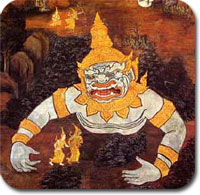
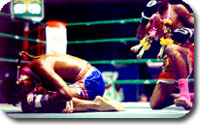
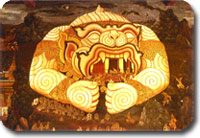
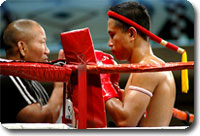
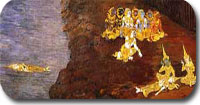
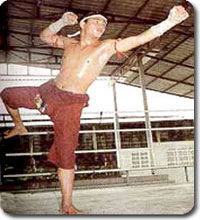
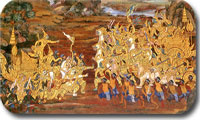
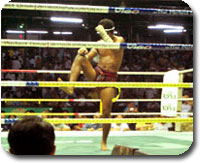
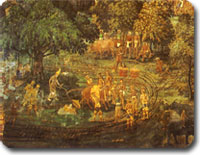
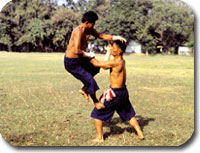
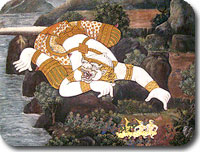
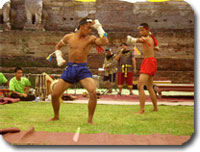
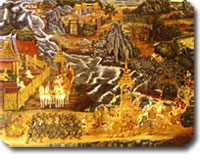
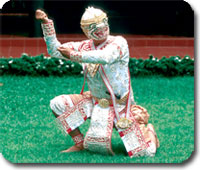
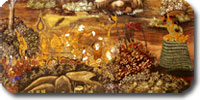
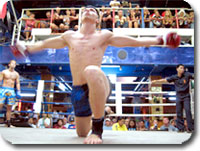
|
'The tale of Prince Rama, his wife Sita and the struggles between good and evil'
Introduction
The story has its origin in the Sanskrit version of Valmiki, written in India at least 2000 years ago. Many Thai poets have borrowed this theme to rewrite it in the Thai style. Several of there rewritten Thai versions still exist, but the most famous and the most complete version of the story is the one written by King Rama I in 1807, 170 years ago. King Rama I is the founder of Bangkok and also the founder of the present ruling dynasty. The story was written in a poetic style and has its theme rooted in the famous frescoes of the temple of the Emerald Buddha in the Grand Palace of Bangkok. The reign of Rama I was characterised by drama-fraught with wars and conquest as he attempted to make his country independent and free from Burmese invasions, and then rebuilding it after it had been destroyed by the wars in the aftermath of the fall of Ayudhya. Yet he found time in the midst of all these wars to create this masterpiece of Thai literature, a work that continues to be read and taught in schools today.
The Thai version of Ramayana is called Ramakian (Ramakirti in Sanskrit, which means in honour of Rama, the hero of the story). The Thai version was adapted to Thai sentiments and characteristics, portraying the customs, beliefs, rules of etiquette and gallantry of Thai ways of life. It is told according to what the Thai's now believe in the world where giants, evil spirits with miraculous and supernatural powers, used to live in order to wreak havoc upon men. The palaces and places the author describes, the dress the people wear in the story, the flowers, the birds and the beauty of the forests depicted, are those of the Thai people and the places surrounding them. The utensils they use, the art forms and the architecture, the forms of entertainment, the ancient art of war, and the ways of expression and the nature of the sentiments expressed, are no longer Indian, but pictures of Thai life.
True, the story is of Indian origin, but the clothes they now wear are characteristic of the Thai's of former days. The story has been developed and adapted to the Thai character that no Thai thinks of it as a thing of foreign origin. It so depicts the Thai way of life and cultural sentiments that it has become a true master-piece of Thai literature. Even the names as originally appearing in the Sanskrit version were changed and are now pronounced in the Thai manner. The details of the description and the events were changed so as to fit Thai reasoning and surroundings. In fact, Rama of the story could have been any Thai king, and the inhabitants none other except the Thai's themselves. The forests, the court intrigue involving the various wives, the love scenes and such can be no other except those characteristic to Thailand. The Indian characteristics to the story have all but lost their meaning. The story has so taken the imagination of the Thai people or rather, the Thai beliefs have been so well incorporated into the story, that the Thai people believe that such things have really happened in the past. Thai mythology still tells of the stories of these gods, goddesses, giants, and other supernatural beings with their mighty powers and exploits as something akin to those of Ulysses from Greek mythology.
The Story is a moral one and depicts the victory of man over the power of evil. The power of evil is represented by a race of giants (or demons) with its own ruler. It begins with the supreme god Shiva, the Almighty and the Creator of the universe.
He created the two chief races on earth, the good one and the evil one. Men are good and giants are bad. Men are polite, tender, and soft. The giants represent all that is ugly, fierce, cruel and characteristic of brute force, evil designs and deceit. The monkeys act as the attendants of men and have taken their side in their battle against the giants. Both giants and men, along with the monkeys, practice the art of war-an art they have learned from hermits living in solitude in the forests.
The hermits belong to the learned and educated class. Through the long practice of holy meditation and sacrifices, these hermits gained sympathy and favours from the Supreme God who granted them all kinds of miraculous powers. By committing to enduring self-abstinence and such practices, they also attained the height of wisdom, which they in turn passed on to their pupils, usually princes. The knowledge they possessed usually encompassed magical incantations and enchantment through which they could invoke rains, storms, lightening, floods, etc. to happen. They can call up any object, sometimes dreadful weapons, or can transform themselves into anything. They can make themselves invulnerable and invisible. They possess all kinds of supernatural power through which to channel their magical arts. They can also turn ordinary weapons into deadly ones which no enemy can withstand and to which no cure is possible under their effect unless through the help of a being of greater magical powers to undo or counteract the fatal effect.
In reading through the story, one must allow free rein to powerful flights of imagination, because both men and giants fight with magic and they invoke fire, winds, fierce animals, serpents and all kinds of destructive means to kill one another. Through out, the opposing side tries to invoke even stronger and more powerful winds, fire and so forth to counteract the forces the other summons up.
As is still the belief, there are heavens, earth an underground world and a world beneath the water. There are gods in the heavens. There are many heavens, one on top of one another so that the higher the heaven, the greater manifestations of bliss and happiness. There is a ruler among the gods, called Indra, and then the supreme ruler of all gods, giants, and men called Shiva, the all-creator from whom the more powerful beings among the gods, giants, and men receive gifts of various degrees of blessings or powerful weapons. It was he who gave orders and ruled the various worlds. As his right hand man and warrior is Narayana, who sleeps on the coiled body of a royal serpent floating on the waves of the ocean. When there was trouble on earth, Narayana was called upon by Shiva to come down, as a reincarnation of various human and mortal forms on earth, to subdue and put an end to the trouble-maker, and eventually to establish peace.
For according to Thai belief, life can be reborn after death and may take different forms. This has led to the belief that if the soul, which is the most animate part of man, could be separated from the body, then the body cannot be put to death. The chief of the giants, Ravana, had attained such power that he could take his soul out from his body and keep it away in a secret, unknown place. In this way, his body would retain immortality, since by trying to kill his body, the soul, which is the living part, is not there to be destroyed. Both his body and his soul, which is life in him, must be destroyed at the same time. Some of the more powerful beings can fly through the air, can separate the earth and delve underneath, can break the water and dive beneath its surface, can lift mountains and uproot big trees.
Beneath the earth lived the underworld giants and royal serpents called Nagas. The Nagas also live at the bottom of the ocean in a world of their own. They all have doings with one another to satiate their self-interest, as well as their lust for love or hatred. They all talked, were able to attain the same magical knowledge and they could all intermarry, which they frequently did. They are just all humans with different names.
There were gods for every element. In fact, the different elements were just the effects of the gods' will. Thus, there was the God of the Sun, the Goddess of the Moon, the God of the Wind, the God of the Rain, the Giant which caused thunder, the Goddess of Lightening, and so on. All gods are living beings capable of love, hatred and giving birth to life.
Some of these gods and goddesses have powerful off-spring inhabiting earth. Being born as god-begotten children, they were endowed with the same powers possessed by their parents and who came to help them in their hours of distress. Thus the monkey Hanuman is the son of the Wind God; Palee, the son of the Sun God; and so on.
Ramayana, or Ramakian, is the story of one of the reincarnations of the God Narayana (Narai in Thai) on earth. He was sent down from Heaven by Shiva in order to fight the power of evil as embodied in the race of giants under the leadership of the wicked Ravana (Totsakan, the ten-headed giant, in Thai).
Chapters
01 ~
02 ~
03 ~
04 ~
05 ~
06 ~
07 ~
08 ~
09 ~
10 ~
11 ~
12 ~
13 ~
14 ~
15 ~
16 ~
17 ~
18
Chapters
19 ~
20 ~
21 ~
22 ~
23 ~
24 ~
25 ~
26 ~
27 ~
28 ~
29 ~
30 ~
31 ~
32 ~
33 ~
34 ~
35 ~
36
Chapters
37 ~
38 ~
39 ~
40 ~
41 ~
42 ~
43 ~
44 ~
45 ~
46 ~
47 ~
48
Researched and adapted from M.L.Manich's book - The Thai Ramayana as written by King Rama I
Here is a good link from another perspective - Learn NC's - 'The Ramayana'
Ramakian's connection to Muay Thai? There are many aspects of Muay Thai that encompass parts of the Ramakian either from the story or from the characters within, such as the Wai Kru, Ram Muay, Trainers Blessing, Training techniques, Aggressive and Defensive tactics. Here are just a few examples of this connection;
The Wai Kru of Hanuman Presents the Ring
(Hanuman goes to Lanka to give Sita a message from Rama) - 'Hanuman Thawai Waen'
Rama sent Hanuman to Lanka to find Sita (who had been captured by the evil Ravana) to give her the message that Rama was coming with his army to save her. Hanuman found her just in time as she was about to kill herself (she was very depressed), but she did not believe what Hanuman was saying and asked for proof, Hanuman presented the ring that Rama had given him to show Sita, when she saw the ring she at once recognised.
The Ram Muay of Rama Shoots the Arrow
(Ravana steals Sita away from Rama) - 'Phra Rama Plang Sorn'
This is a story that tells of the demon Mareet, who transforms himself into a beautiful golden deer so that Sita, Rama's wife would see the creature in the forest and ask Rama to catch it for her. Once Rama had gone looking for the deer, the evil Mareet was to cry out in the voice of Rama as if he had been injured, to lure Lakshaman (Rama's brother who was travelling with them) to go looking for his injured brother, leaving Sita all alone. This would then give Ravana a chance to steal Sita away for himself, taking her back to Lanka.
The Trainers Blessing from the God of Wind
(The births of Palee, Sugriva and Hanuman)
When the trainer removes the Mongkon from the Nak Muay's head after the Ram Muay has been performed, the trainer will blow gently over the fighters head (symbolising Pai, the God of Wind has just pasted over the fighter) awakening the warrior spirit within. It is also believed that by doing this the Nak Muay will be given the same protection and courage as Hanuman to win this on coming battle.
The Footwork of Rama's Three Strides
(His three strides to take back all the land) - 'Yaang Saam Khum'
This is a story of great cunning by Rama, who was sent by Shiva to get rid of an evil giant named Tatawan. Rama cleverly disguised himself as a Brahman, and convinced the giant to allow him to perform a magic rite on his land. The Brahman asked for a small piece of land which measured no more than three strides in size to perform the rite, the giant agreed as he believed that this Brahman was to small to take to much land and to easy to kill. Rama then transformed himself back into his almighty self and performed three strides covering the whole of the giants territory, taking back all of the land. When the giant saw it was Lord Rama, he tried to flee but having nowhere to run was slain.
The Muay Boran Aggressive Technique of Giant Throws the Ax
(The fight between the Goddess of Light and the Father of Thunder) - 'Ramasun Kwang Kwan'
This story tells of an evil giant called Ramasun (Father of Thunder) who had forever chased a beautiful Goddess named Mekkhala (Goddess of Light), one day he could see her dancing around with a big beautiful diamond in her hand. Ramasun wanted it and her for himself, and chased after Mekkhala who quickly escaped from him every time he tried. He grew very angry, taking out his axe in frustration he threw it, the hurling of the axe caused a tremendous noise, like a boom of thunder. A mighty God called Orajun caught the axe, a fight begun between him and Ramasun for the return of the powerful weapon.
The Muay Boran Defensive Technique of Monkey Beats the Giant
(The Battle of Kumprakarn) - 'Hanuman Fad Kumprakarn'
This story tells of the evil giant Kumprakarns trickery over the monkey Sugriva (the child of the Sun God) who was captured and taken back to the city of Lanka. But before Kumprakarn passed the city gate, Hanuman surprised him and a battle commenced in which Hanuman succesfully beat Kumprakarn and took back Sugriva to safety.
|